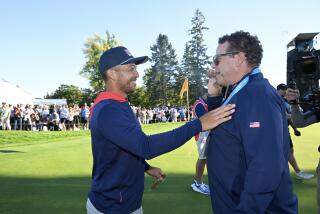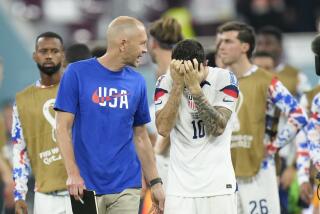Stars & Stripesâ Hopes Flagging After Defeat : Defenders: America 3 wins by 3:31 to take 4-1 lead in series.
SAN DIEGO â Dennis Conner looked around on the dais at the Americaâs Cup defendersâ post-race press conference Friday and noted, âItâs getting a little lonely up here.â
The America 3 representative had not yet arrived, and Stars & Stripes tactician Tom Whidden, who usually sits alongside his skipper providing moral support, was down in the audience.
âEven Curly has abandoned me,â Conner said.
What else could Conner do but joke? He had just gone down by 4-1 in the best-of-13 series in losing to America 3, the boat, by 3 minutes, 31 seconds--a margin exaggerated by the dying wind near the end but a loss nevertheless.
The elegant but elderly Stars & Stripes had its moments Thursday, leading for a while on the first leg and regaining the lead on the next, downwind leg. But unlike Wednesdayâs race when the America 3crew seemed ready for a sailing lesson, Bill Kochâs Cubens were solid this time.
Stars & Stripesâ big moment came about one minute before the first windward mark when, trailing America 3 by two lengths, Whidden suggested using a spinnaker instead of the smaller reaching gennaker headsail they had ready for the downwind leg.
Conner said, âWe generally try to make our downwind headsail call three or four minutes before the mark to give the guys a chance to set up and get the right one on top. Approaching the mark we seemed to have a little increase in breeze, and Tom said, âWhat would you think about a spinnaker?â â
It takes more wind to make the big, billowing spinnakers work, and Whidden thought there was just enough.
âIt seemed like the right call to me, with relatively smooth water and a breeze coming up,â Conner said. âI just encouraged the guys to get the job done.â
Two advantages of a spinnaker are being able to sail âdeeper,â or more directly toward the downwind mark, and jibing--switching from one sailing angle to the other--more efficiently because no wind is spilled if the spinnaker is shifted properly, while a gennaker must be pulled around the headstay to the other side and reset. These boats are so swift that they sail best directly downwind only in the strongest blows.
After a series of jibes halfway down the leg, Stars & Stripes crossed in front of America 3for the lead, which it extended to 16 seconds at the mark.
America 3 tactician Dave Dellenbaugh said, âWhen the wind came up from maybe 9 to 10 knots in the last minute or two to the mark, we had (already) made the call to go to the (gennaker). The option is to change on the run, but when youâre that close a change is gonna cost you more than itâs worth.â
But the lesson was that it didnât really matter how many things Stars & Stripes did right, because if America 3 doesnât do enough things wrong it will usually be a disappointing day for the midnight-blue boat.
Whitecaps appeared on the next upwind leg, indicating that the wind was over 10 knots, and Conner could read the handwriting on the water. Thatâs the kind of wind that stirs the sleeping giant.
It wasnât long before America 3 helmsman Buddy Melges was coming at them like an 18-wheeler in the fast lane. On only the second try he crossed Stars & Stripes on port tack, ignoring Connerâs starboard right of way. Conner fought back through 15 tacks but couldnât get back into the race.
Dellenbaugh, arriving late to sit alongside Conner, was as diplomatic as he could have been.
âWhen we get over 9 knots of wind or so, um, we have a little bit of speed advantage . . . it seems,â he said. âAnd, uh, if weâre close behind, thereâs a good chance weâre gonna be in a position where we can put that to work, and we were able to do that.â
Dellenbaugh almost seemed apologetic.
âItâs always a little bit difficult coming from behind, because the boat thatâs ahead, if they play the wind shifts correctly, has an advantage . . . and these guys have done a nice job and made it hard to get by,â Dellenbaugh said. âOur plan was to stay close and use our speed up the second beat.â
Conner said, âWe tried (sailing) a little low (for speed) and then tried a little high (for a better angle). It didnât make any difference. They were just going very well.â
Thatâs when it gets lonely in the boat thatâs behind.


